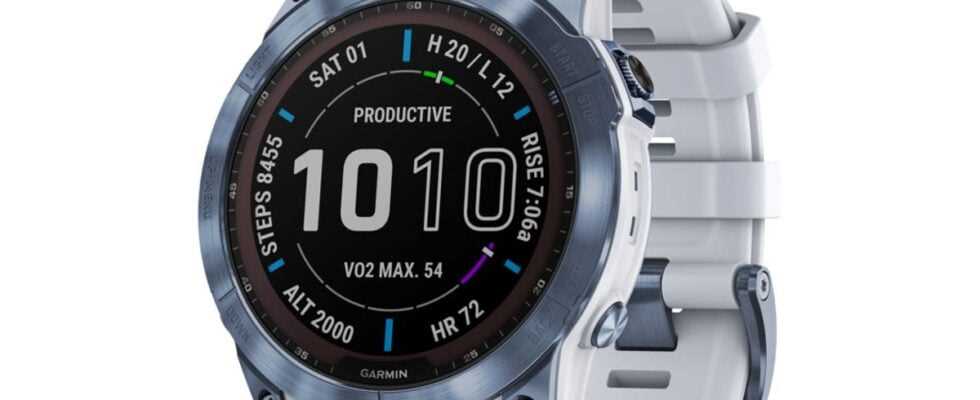The benchmark for outdoor multisport watches, Garmin’s Fēnix is now in version 7. Although it is still intended for experienced athletes, it is more accessible and versatile.
Intended primarily for sports enthusiasts of outdoor activities, Garmin’s Fēnix watch has established itself over the years as a benchmark in this so-called “outdoor” category. Robust and very complete, it nevertheless had to evolve in order to face ever sharper competition, which does not hesitate to bring modernity to a rather traditionalist world of sports watches.
Now, the Fēnix 7 has a more up-to-date design. Its case – made of fiber-reinforced polymer and resistant to immersion at 10 ATM – is thinner and its narrower bezel (2 mm) leaves more room for the solar sensor nestled under the glass (+54% for the capture area ). The bezel, in steel or titanium depending on the version, extends over the horns of the case where the screws are now located, guaranteeing, according to Garmin, a more resistant strap attachment.
Three sizes and as many variations
To suit the thinnest and thickest wrists, the 47mm Fēnix 7 is available in two other versions called 7S and 7X, displaying respective sizes of 42 and 51 mm.
The Fēnix 7S, 7 and 7X have respectively a 1.2 inch (240 x 240 pixels), 1.3 inch (260 x 260 pixels) and 1.4 inch (280 x 280 pixels) screen. Watches of different sizes, available with or without solar sensor and equipped with classic Corning Gorilla glass or more resistant Sapphire glass.
The touch screen in addition to the buttons
The main novelty of these screens concerns their tactile capacity. The Fēnix 7 does not abandon its five buttons – fully configurable – but also offers a more up-to-date user interface, without imposing it on those who do not like to manipulate their watch in this way. The touch nevertheless brings more comfort in the navigation, in particular when it is a question of using the cartography. The entire interface has been revised for the occasion, the Fēnix 7 also always connecting to the Garmin Connect application.
Increased autonomy and more efficient solar charging
This Garmin is also progressing on the autonomy front. The manufacturer promises 37 days of operation in connected watch mode, 135 hours with GPS activated and up to 161 hours in UltraTrac battery saving mode (for ultra-trail runners, in particular).
The efficiency of Solar technology also goes up a notch, Garmin announcing an increased solar energy capture of 105% compared to a Fēnix 6 Solar.
More precise sensors, a lamp for safety
On the hardware level, Garmin indicates that it has improved the accuracy of the barometric altimeter. You can also count on a Garmin Elevate Gen 4 cardio sensor that works underwater, as well as a pulse oximeter (SpO2) Pulse Ox 2.0, announced as more precise for the analysis of recovery and sleep.
Available only on Sapphire Solar models, the GPS chip manages multiband, improving accuracy in isolated areas (canyons, cities, etc.).
Taking advantage of its larger size, the Fēnix 7X incorporates an LED flashlight to illuminate the road and, above all, to be seen when running at night. A strobe mode is also included, alternating red lighting when the arm goes backwards and white lighting when it goes forwards.
Better performance tracking
When it comes to sport modes, Fēnix 7 packs a punch, offering no less than 1,400 customizable workouts, a selection of high-intensity interval workouts (HIIT), plus new activity profiles like surfing, windsurfing, kitesurfing…
For their part, runners will appreciate the “On the route” (Up Ahead) function, which is used to specify the location of refueling points and other points of interest on a route. The watch indeed integrates a cartography updated directly via the wifi. No need to go through a computer. The standard Fēnix 7 and Solar have 16 GB of internal memory to do this, while the Sapphire Solar have 32 GB.
Performance and capacity monitoring is not left out with the Race Predictor Trend feature, designed to predict race times over the long term. The Fēnix 7 is also able to estimate the level of endurance in real time. A feature called Stamina which provides, among other things, an estimate of the distance that we can travel according to the energy that we consume.
More health and connected functions
Regarding health and well-being, the Fēnix 7 offers a specific activity allowing you to obtain a compilation of data in just 2 minutes, with a view to transmitting it to a professional.
Sleep tracking is also handled by the watch, similar to the Venu 2, for example. In addition, the Fēnix 7 takes over all the functions of connected watches such as music management and NFC payment.
High-end positioning
Very complete and designed to withstand difficult conditions, the Fēnix is positioned in a high-end segment. The classic 7 and 7S are sold from €699.99, followed by the 7 and 7S Solar versions at €100 more. Count another 100 € extra for the Sapphire Solar versions. The latter are also available in a titanium version with a leather strap (€999.99), and a titanium bracelet (€1,149.99).
The Fēnix 7X is only available in the Solar version at €899.99 or Sapphire Solar at €999.99, with titanium versions as well.
